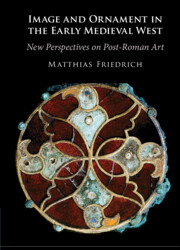Book contents
- Image and Ornament in the Early Medieval West
- Image and Ornament in the Early Medieval West
- Copyright page
- Dedication
- Contents
- Figures
- Plates
- Acknowledgements
- Introduction
- I Moving beyond Dichotomies
- One The Great Divide
- Two The Enduring Power of Images
- II New Perspectives
- References
- Index
- Plate Section (PDF Only)
One - The Great Divide
from I - Moving beyond Dichotomies
Published online by Cambridge University Press: 14 January 2023
- Image and Ornament in the Early Medieval West
- Image and Ornament in the Early Medieval West
- Copyright page
- Dedication
- Contents
- Figures
- Plates
- Acknowledgements
- Introduction
- I Moving beyond Dichotomies
- One The Great Divide
- Two The Enduring Power of Images
- II New Perspectives
- References
- Index
- Plate Section (PDF Only)
Summary
Ethnicity and identity have formed a major focus in late antique and early medieval archaeology and history. Wide-ranging debates between the so-called Vienna and Toronto Schools have had massive impacts beyond early medieval history, as has the famous project, The Transformation of the Roman World.1 Here, a new paradigm emerged, slowly substituting the previous ‘decline-and-fall’ ideas of the antique world with that of ‘transformation’. The study of late Antiquity and the early Middle Ages in the Roman West is thus very much entangled with research on identity, ethnicity, and grand narratives, such as transformation or decline, ‘Germanic’ or barbarian invasions. These influential concepts and ideas should not be underestimated in the study of art and visual culture as they too frame the historical scenes in which art history is set. Since the mid-2000s, there have been new debates, mostly (but not solely) triggered by Heather, Ward-Perkins, and Halsall.2 The question of the extent to which ethnicity has played a significant role in the use of material culture, and to which it can thereby be identified in the archaeological record, has been widely, and often intensely, debated across late antique and medieval archaeology.3 The research on art and visual culture, however, embarked on a different tangent. Largely ignoring recent debates in history and archaeology, most scholars still emphasise the function of early medieval art and images as fostering perceptions of ‘Germanic’ identity, ethnicity, or religion.4 But why does the ‘Germanic’ remain such a pervasive terminology?
- Type
- Chapter
- Information
- Image and Ornament in the Early Medieval WestNew Perspectives on Post-Roman Art, pp. 7 - 36Publisher: Cambridge University PressPrint publication year: 2023

